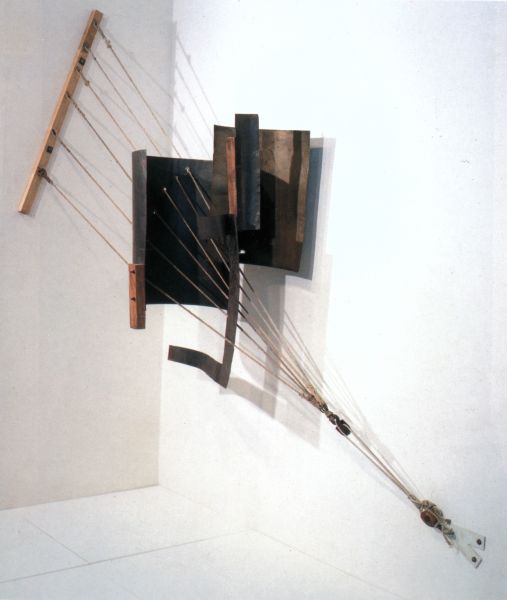|
|
Corner Counter-Relief. 1914

Tatlin Vladimir,
71 x 118
State Russian Museum
Annotation
Corner Counter-Relief (with Cables) was first exhibited during the Last futuristic paintings exhibition “0.10” in Petrograd in 1915. This abstract volumetric and spatial composition was supposed to be perceived as a continuation and development of the Nonobjectivity idea. The same idea was previously expressed by Tatlin in his “painted reliefs” based on the combination of contrasting textures (paper, glass, plaster, wood, and tin). The novelty of the Corner Counter-Relief lied in the artist’s desire to abandon the traditional “painting plane” and to bring nonobjective constructions into space formed by two inclined panes. They were used not only for the hanging of the composition, but also to create an abstract background emphasizing its volume. It was also important for the artist to show all abilities of the materials used by him. In this work they represent opposed yet inseparable notions – flexibility and rigidness, freedom and tension, movement and calmness.
Author's Biography
Tatlin Vladimir
Tatlin, Vladimir Yevgrafovich
1885, Moscow -1953, Moscow
Painter, graphic artist, theatrical designer, author of architectural and engineering projects. Studied at the Penza School of Art (1904-10) and under Valentin Serov and Konstantin Korovin at the Moscow School of Painting, Sculpture and Architecture (1902-03, 1909-10). Contributed to the exhibitions of Donkey''s Tail (1912), Jack of Diamonds (1913), World of Art (1913), Union of Youth (1910-14), Tramcar V. First Futurist Exhibition (1915), 0,10. Last Futurist Exhibition (1915-16) and Store (1916). Member of the Unification of New Trends in Art (1922-23). Chairman of the Left Federation of Artists in Moscow (1917), head of the Moscow committee of Narkompros (1918-19). One of the initiators of the creation of the Museum of Painterly Culture, Museum of Artistic Culture and the Institute of Artistic Culture. Headed the department of material culture at the Institute of Artistic Culture. Taught in Petrograd, Kiev and Moscow. Headed the Narkompros Experimental Laboratory (1929-32

